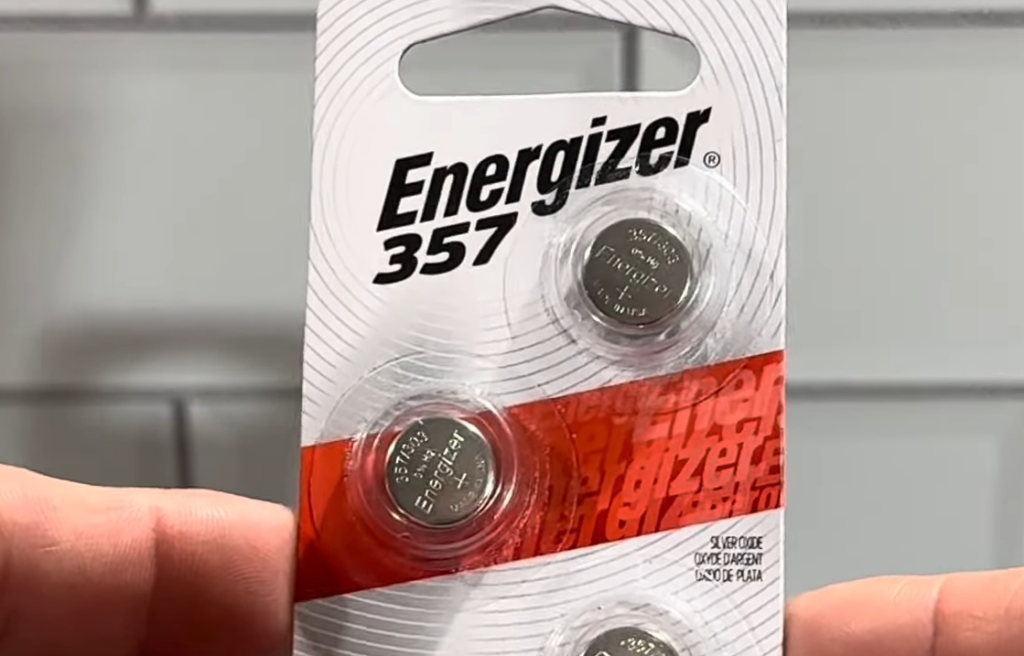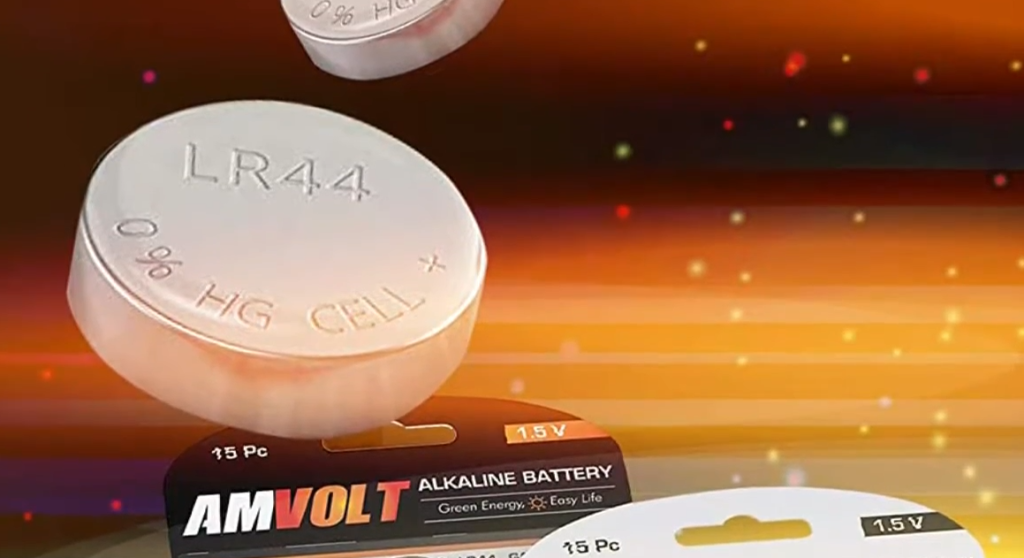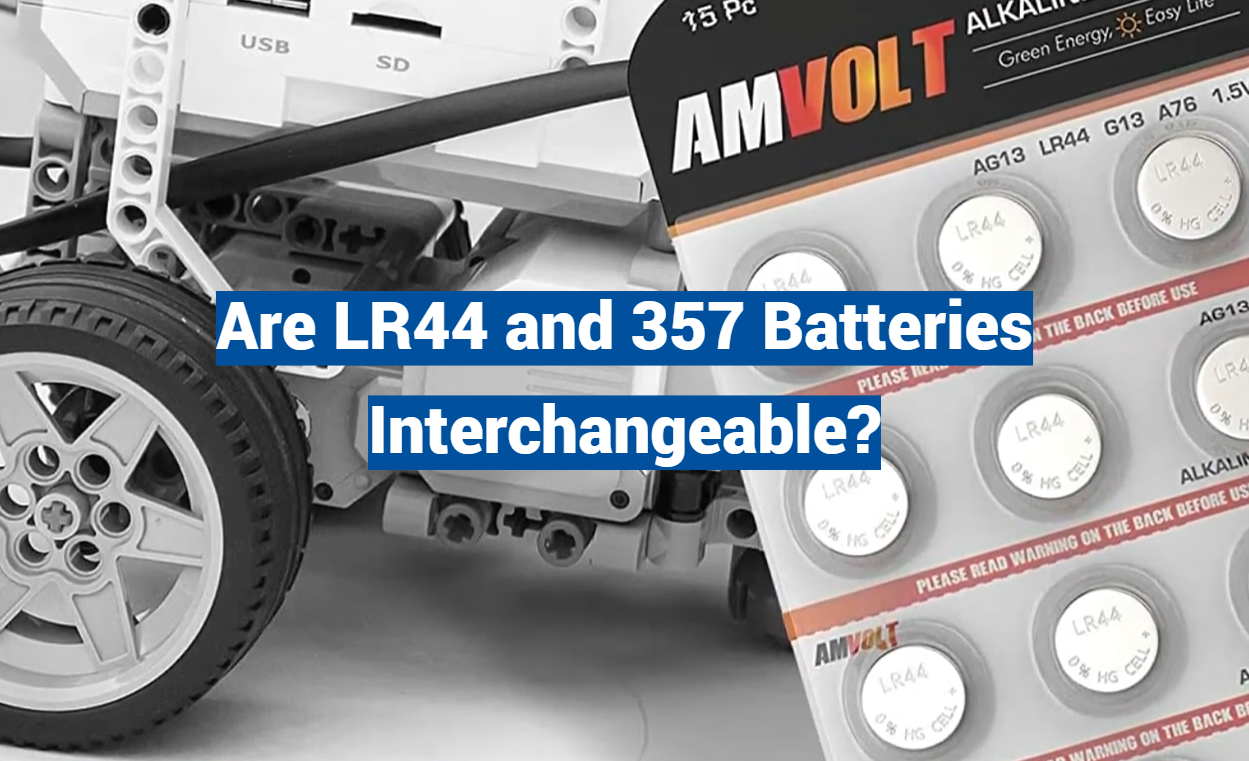Have you ever found yourself in a frenzy, desperately rummaging through your junk drawer, hoping to find just one tiny battery that could save the day? Perhaps your remote control died mid-movie, or your favorite toy decided to go on strike just as you were about to entertain a group of friends. The struggle is real when it comes to finding the right batteries, but fear not, for today this guide will dive into the marvelous world of LR44 and 357 batteries to determine whether they can save you from that ever-dreaded power outage. So, sit back, relax, and prepare to be enlightened, as this guide unravels the mystery of their interchangeability.
What are Alkaline Batteries and Silver-Oxide Batteries?

Silver-oxide batteries are also a type of primary cell, but they’re mostly used to power devices that require precise voltage regulation and higher energy output. Silver-oxide batteries are commonly used in watches, calculators, hearing aids, and medical equipment due to their ability to provide stable current over a long period. Silver-oxide batteries are typically more expensive than alkaline batteries, but they last longer.
Both alkaline and silver-oxide batteries have their advantages and disadvantages. Alkaline batteries are usually less expensive and widely available, whereas silver-oxide batteries are more powerful and can last longer. Ultimately, it’s up to the user to decide which type of battery is best suited for their needs. With the right information, it’s easy to make an informed decision on which battery type is best.
There are also other types of batteries available that may offer a better value depending on one’s specific needs. For example, rechargeable batteries are becoming increasingly popular because they can be recharged and used multiple times, making them more cost-effective than single-use batteries. Lithium-ion and nickel-metal hydride batteries are also becoming increasingly popular due to their higher energy density, long lifespan, and low cost. Ultimately, there is no one-size-fits-all solution when it comes to battery power; the best option depends on the individual’s needs and budget [1].
Overview of LR44 Battery
The LR44 battery is a type of alkaline button cell battery that typically powers small electronic devices such as wristwatches, toys and calculators. It is also known by its other common names, including A76, A-76, AG13 and L1154.
This type of battery has many advantages over traditional batteries. It offers higher energy density and more efficient power delivery than regular zinc-carbon batteries. Additionally, it can be recharged multiple times without losing its capacity or damaging the device connected to it. The LR44 battery is also much smaller than other types of batteries, making it ideal for powering small electronic devices that require a compact size.
LR44 batteries are available in both non-rechargeable and rechargeable varieties, depending on the application. Non-rechargeable batteries are typically used in toys, remote control devices and calculators that require a short burst of power. Rechargeable LR44 batteries are better suited for long-term use in watches and other electronic devices that need consistent power.
When using LR44 batteries, it is important to pay attention to the battery’s voltage, as many devices require a specific voltage to work properly. Additionally, when replacing LR44 batteries it is important to use the correct size and type of battery for the device in question. Failing to do so may damage your device or shorten its lifespan. Additionally, it is best to store LR44 batteries in a cool, dry place away from direct sunlight and extreme temperatures.

Overall, the LR44 battery is a great choice for powering small electronic devices that require a compact form factor. It offers more efficient power delivery than traditional batteries, as well as being rechargeable in some cases. When using LR44 batteries it is important to pay attention to the device’s voltage requirements and ensure you are using the right type of battery for the job. With proper care and maintenance, LR44 batteries can provide reliable power for a variety of applications [1].
Overview of 357 Battery
A 357 battery is a type of small, lightweight battery often used in watches and calculators. It is composed of four alkaline cells enclosed within a metal canister. The 357 battery provides higher voltage than comparable-sized batteries and is considered to be very reliable.
The 357 battery has evolved to become more efficient and longer lasting. Modern versions are designed to be more energy efficient and last up to five times longer than older models. Additionally, newer 357 batteries are made with less harmful chemicals such as mercury and cadmium, making them safer for the environment.
In addition to its use in watches and calculators, the 357 battery is commonly used in other small electronic devices such as remote controls, flashlights, and hearing aids. Its small size makes it a great choice for applications where space is limited, such as in jewelry or other small items.
While the 357 battery offers many advantages, it does have some drawbacks. It has a relatively short life span compared to other types of batteries and needs to be replaced frequently. Additionally, the metal canister can corrode if exposed to moisture, making it less reliable in certain conditions.
For these reasons, it is important to carefully consider the applications for which a 357 battery is best suited. If you are looking for a reliable and efficient power source for your small electronic device, then the 357 battery may be the right choice for you. With proper care and maintenance, this type of battery can offer many years of reliable power.
Additionally, there are a variety of 357 batteries available to choose from, ranging in size, voltage, and performance levels. This means that you can find the best option for your specific application needs. With careful research and selection, you can ensure that your device has an efficient and long-lasting power source.

LR44 vs 357: What’s The Difference Between Them?
Chemical composition
The primary difference between LR44 and 357 batteries lies in their chemical composition. The LR44 battery is composed of an alkaline-manganese dioxide combination, which provides a reliable and long-lasting power source. On the other hand, the 357 battery combines silver oxide and zinc, offering a high-energy density and stable voltage output.
These distinct chemical compositions give each battery type its unique set of performance characteristics. The LR44 battery is known for its versatility and suitability for a wide range of devices, while the 357 battery excels in applications that require consistent power delivery over an extended period. It’s important to use each battery type with devices that are compatible to ensure optimal performance and longevity.
Understanding the differences in chemical composition and performance characteristics of LR44 and 357 batteries allows consumers to make informed decisions when selecting the appropriate power source for their specific needs.
Voltage
The LR44 battery, commonly used in small electronic devices, has a nominal voltage of 1.5 volts, providing a reliable power source. On the other hand, the 357 battery offers a slightly higher output of 1.55 volts, making it suitable for devices that require a bit more energy. This subtle voltage difference is crucial in ensuring optimal compatibility between batteries and various electronic devices. By understanding these nuances, you can confidently choose the right battery for your specific needs.
Size and Weight
The LR44 battery is physically smaller than the 357, measuring 11.6 millimeters in diameter and 5.4 millimeters in height, while the 357 measures 13.5 millimeters in diameter and 7.9 millimeters in height. This makes it easier to fit into devices with limited space for batteries, such as watches or hearing aids. Additionally, the LR44 battery weighs significantly less than the 357, making it ideal for applications that involve frequent battery changes.
Nominal capacity
The LR44 battery offers a nominal capacity of 135 mAh, while the 357 battery provides a slightly higher capacity of 150 mAh. This difference is primarily due to their distinct chemical compositions, as the alkaline-manganese combination used in LR44 batteries has a lower energy density than that of silver oxide and zinc found in 357 batteries. As such, the higher capacity of the 357 battery offers a more reliable power source for applications that require sustained operations over longer periods.

Cost
The LR44 battery is usually cheaper than the 357, as it requires fewer materials to produce and is more widely available on the market. That being said, it’s important to note that the actual cost can vary depending on factors such as manufacturer, availability, and quantity purchased. Ultimately, the cost of batteries should not be the main factor in deciding which type to use as it is important to make sure you are selecting a battery that meets your needs and can provide reliable performance for the device you are using it with.
Leakage resistance
Both LR44 and 357 batteries are designed to be leak-resistant, although the 357 battery offers a greater degree of protection in this regard. This is due to its higher voltage output, which helps minimize the risk of leakage or corrosion from exposure to moisture or other external factors. The additional protection provided by the 357 battery makes it ideal for devices that require sustained operations over longer periods, such as smoke detectors or medical equipment.
Operating temperatures
The LR44 battery is designed to operate in temperatures ranging from -20°C to 54°C, while the 357 has a wider operating range, spanning from -30°C to 70°C. This makes the 357 battery better suited for applications in extreme temperatures, such as those found in medical equipment or outdoor lighting systems. With this knowledge, you can confidently choose the right battery for your application and ensure reliable power delivery in even the most demanding environments.
Safety
Safety is always a major concern when selecting the right battery for your device. The LR44 and 357 batteries both come with built-in safety features to prevent overcharging, overheating, and short-circuiting. Additionally, the 357 offers better protection against leakage and corrosion due to its higher voltage output. Therefore, it’s important to evaluate your specific needs before making a decision and ensure that the battery you choose will provide reliable and safe performance.
Performance and reliability
The LR44 battery offers a reliable and long-lasting performance, making it suitable for a wide range of devices. On the other hand, the 357 battery provides an even more consistent and powerful supply of energy, making it ideal for high-drain applications that require sustained operations over longer periods. Knowing the differences between these two types of batteries allows you to make informed choices and ensure that you are selecting the best battery for your specific needs. Additionally, understanding their distinct chemical compositions helps to guarantee optimal performance and maximum longevity of your device [3].

Applications of LR44 and 357 batteries
LR44 and 357 batteries have a wide variety of applications. They are used in watches, calculators, electronic scales, laser pointers, medical instruments, toys, remote controls and more. These small batteries are also used in hearing aids to power the amplifier and microphone. The LR44 is widely used in cameras as well as some other devices because of its low cost and long life. The 357 is used in digital cameras, clocks, radios and other portable electronic devices.
LR44 batteries are also often used as replacement batteries for car keys, keyless entry systems, security systems and garage door openers. They also have applications in wireless mice, game controllers and other remote control devices requiring small amounts of power. The 357 battery is often used as a power source for laptop computers and other portable electronic devices.
LR44 and 357 batteries are also popular in home security systems, smoke detectors and carbon monoxide detectors where reliable and long-lasting power is needed. They also provide emergency backup power for medical equipment such as glucose monitors, defibrillators and pacemakers. In addition to these applications, LR44 and 357 batteries are also used in LED flashlights, bicycle lights and other portable lighting devices. With their compact size and long life, these small batteries can provide reliable power for a variety of electronic applications.
LR44 and 357 batteries offer a great combination of high energy capacity, low cost and long life. They have become the battery of choice for many small electronic devices. As technology advances and new applications emerge, these batteries will continue to be a popular power source for a wide range of applications.

FAQ
Are LR44 batteries the same as 357 303?
LR44 batteries, also commonly referred to as 357, 303, or A76 batteries, are a versatile power source. These batteries share the same size, voltage rating, and chemical composition, making them interchangeable. So, whether you need an LR44, 357, 303, or A76 battery, rest assured that they all belong to the same family of batteries, providing reliable energy for a wide range of electronic devices.
Do LR44 batteries last for a long time?
LR44 batteries can last anywhere from one to three years depending on usage and storage conditions. With proper care and storage, you can maximize their lifespan and get the most out of your battery power source. To ensure maximum battery performance, make sure to store them in a cool, dry environment away from extreme temperatures. Additionally, always check to see if the battery has reached its end of life before replacing it with a new one. This will help save time and money as well as reduce unnecessary waste.
What can I do to make my LR44 batteries last longer?
You can take several steps to increase the lifespan of your LR44 batteries. First, keep them stored in a cool, dry environment away from extreme temperatures. Additionally, check that the battery terminals are free from any corrosion or dirt before and after each use to ensure good conductivity. Finally, be sure to replace your batteries when they have reached their end of life and not before – this will help save time and money as well as reduce unnecessary waste. Following these tips will help you get the most out of your LR44 batteries so that you can power all your electronic devices with ease.
What battery replaces LR44?
The LR44 battery is a versatile power source and can be replaced with other batteries such as CR44, SR44, AG13, A76, G13A or 357. However, it is important to note that the voltage ratings of these alternative batteries may differ from the original LR44 battery. If you are unsure which power source is compatible with your device, make sure to consult the user manual or contact the manufacturer for more information.
Where can I buy LR44 batteries?
LR44 batteries are widely available in many stores and online retailers. You can typically find them at pharmacies, convenience stores, supermarkets, as well as local electronics or hardware stores. Additionally, you can also purchase LR44 batteries from various online retailers, such as Amazon.com or Battery Warehouse. So, no matter where you live, you should be able to find LR44 batteries with ease.
Are LR44 batteries rechargeable?
No, LR44 batteries are not technically rechargeable. However, some aftermarket solutions claim to offer a recharging system for LR44 batteries. While these products may provide some level of convenience, it is important to note that they can significantly reduce the lifespan and performance of the LR44 battery. As such, we recommend using traditional LR44 batteries or other non-rechargeable power sources for your electronic devices.
Conclusion Paragraph
So, can LR44 and 357 batteries be interchangeable? The answer is not an absolute yes or no. In certain applications, the two batteries may be suitable for interchangeability but in others, they may not. Ultimately, it is up to the user to decide what works best for their individual needs and equipment requirements. If any confusion exists, contact a professional battery specialist for further assistance before attempting to use either of these batteries for your application. Keep in mind that both LR44 and 357 batteries can be dangerous if handled improperly, so it is important to take the necessary precautions when dealing with these types of batteries.
Useful Video: Energizer 357 Batteries – Replaces LR44 / 303 / AG13 / SR44
References:
- https://www.allthescience.org/what-is-a-silver-oxide-battery.htm
- https://www.batterystation.co.uk/battery-types/button-cells-coin-cells/lr44-a76-button-cells.html
- https://www.utmel.com/components/lr44-vs-357-are-lr44-and-357-cells-interchangeable?id=898

